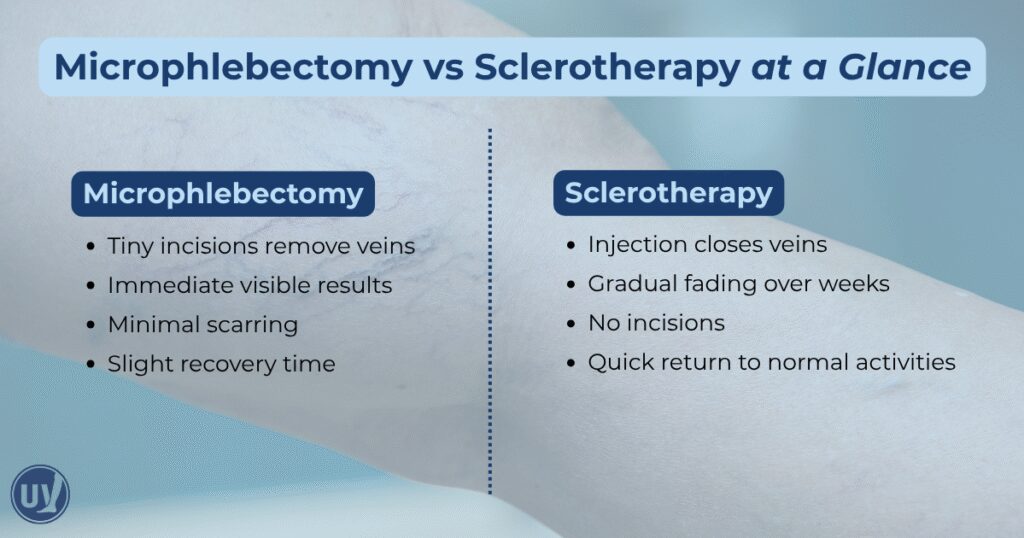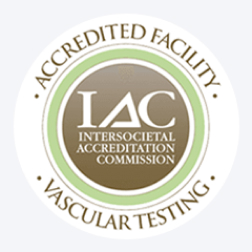Small veins can be more than a cosmetic concern, they can cause discomfort and affect confidence. Fortunately, modern vein treatments make it easier than ever to address these issues safely and effectively. Two of the most popular options are microphlebectomy and sclerotherapy, both minimally invasive procedures designed to improve the appearance and health of your veins.
Microphlebectomy removes small veins through tiny incisions, providing immediate results with minimal scarring, ideal for larger veins close to the skin’s surface. Sclerotherapy uses a specialized solution injected directly into the vein, causing it to collapse and gradually fade, often with little to no downtime.
Each treatment has unique benefits, recovery considerations, and suitability depending on vein size, location, and personal preferences. Consulting a vein specialist at United Vein & Vascular Centers can help you choose the approach that’s right for you, giving you confidence, comfort, and healthier-looking legs.
Understanding Small Vein Conditions
Small vein conditions, such as varicose veins, can cause discomfort. They often appear as visible, twisted veins on the legs.
Varicose veins are typically larger and raised. They can result in pain, swelling, and a heavy feeling in the legs.
Common symptoms of small vein conditions may include:
- Aching or throbbing in the legs
- Swelling, especially after standing or sitting
- Itching or skin changes around the veins
While these conditions can be bothersome, effective treatments are available.
Understanding your vein condition is vital. It enables you to select the treatment that aligns with your needs. Consulting a healthcare provider can help clarify these options. Early intervention can prevent complications and improve your quality of life.
What Is Microphlebectomy?
Microphlebectomy is a minimally invasive procedure designed to address varicose veins. It involves the physical removal of small veins through tiny skin incisions. This technique is typically used for veins that are close to the skin’s surface and too large for sclerotherapy.
Before the procedure, the area is numbed with local anesthesia. This ensures a pain-free experience for the patient. During microphlebectomy, a specialized hook tool is inserted through a small incision to extract the vein.
The treatment typically results in immediate removal of the problem vein. There is usually minimal scarring as the incisions are small. This helps to maintain a clear and smooth skin appearance post-procedure.
Patients often prefer microphlebectomy because it produces fast, noticeable results. Unlike treatments that rely on gradual vein absorption, microphlebectomy offers tangible immediate benefits. This can make it a great choice for those seeking swift relief.
Key steps in microphlebectomy typically include:
- Local anesthesia administration
- Small skin incisions
- Extraction of the varicose vein
- Post-procedure compression to aid healing
Discussing microphlebectomy benefits with a vein specialist is important. They can provide personalized insights and determine the suitability of this option for your specific condition.
Microphlebectomy Benefits and Recovery
The benefits of microphlebectomy are numerous, making it a popular choice for varicose vein treatment. First, the procedure offers immediate removal of the vein, providing quick visual results. Patients often appreciate this immediate transformation in the appearance of their veins.
Another significant advantage is the minimal scarring that occurs due to the small incisions used. This is particularly appealing for those concerned about aesthetic outcomes. The minimally invasive nature of the procedure supports faster healing with fewer visible marks.
Additionally, microphlebectomy can alleviate discomfort associated with varicose veins, such as pain and heaviness in the legs. This can significantly improve a patient’s quality of life. Patients can quickly return to their daily activities, often within a few days post-procedure.
Recovery from microphlebectomy is typically uncomplicated. However, it may involve some bruising and swelling at the incision sites. These side effects are usually minor and resolve quickly.
To enhance recovery and ensure optimal results, patients are advised to follow post-procedure care instructions. This often includes wearing compression stockings to aid healing and prevent complications. Post-procedure guidelines generally involve:
- Uso de medias de compresión
- Avoiding strenuous activities initially
- Keeping incision areas clean
- Attending follow-up appointments with the doctor
Microphlebectomy offers an effective treatment for those seeking immediate relief with minimal downtime. Consulting with a vein specialist can help determine if this option aligns with your health and aesthetic goals.
¿Qué es la escleroterapia?
Sclerotherapy is a widely used treatment for small varicose and spider veins. This procedure involves injecting a special solution, known as a sclerosant, into the affected veins. The solution causes the veins to collapse and eventually be absorbed by the body, redirecting blood flow to healthier veins.
The procedure is often favored for its non-invasive nature. Unlike surgical methods, sclerotherapy does not require incisions, which reduces the risk of scarring. This is particularly beneficial for those concerned about maintaining smooth skin after treatment.
Sclerotherapy is typically performed on an outpatient basis, meaning patients can go home the same day. The entire procedure is swift, often completed within 30 minutes to an hour. This quick turnaround can be a significant benefit for those with busy schedules.
Patients undergoing sclerotherapy can expect minimal discomfort. The injection process is generally well-tolerated, with most patients experiencing only a slight stinging sensation. To improve outcomes, compression stockings are usually recommended after treatment.
The advantages of sclerotherapy include:
- Quick and efficient procedure
- No need for surgical incisions
- Minimal discomfort during treatment
- Little to no downtime required
For those dealing with smaller veins, sclerotherapy offers a simple yet effective treatment option. Consult with a healthcare provider to explore if sclerotherapy aligns with your specific needs.
Sclerotherapy Procedure and Recovery
Sclerotherapy begins with a consultation to determine the appropriate treatment plan. During the procedure, a sclerosant solution is injected directly into the targeted veins. This solution irritates the lining of the vessels, causing them to seal and eventually disappear.
The number of injections and sessions required depends on the size and number of veins. Often, multiple treatment sessions are necessary to achieve the desired results. Each session typically lasts between 15 to 30 minutes, making it a convenient option for many patients.
Recovery from sclerotherapy is generally fast and straightforward. Many patients return to their daily activities immediately following treatment. However, some precautions are advised to ensure optimal healing and results.
Post-procedure care often includes wearing compression stockings. These stockings help to maintain pressure on the treated veins, promoting faster healing. Additionally, patients are usually encouraged to avoid vigorous exercise for a few days.
The typical recovery guidance includes:
- Wearing compression stockings for up to two weeks
- Avoiding heavy lifting and intense exercise
- Walking regularly to promote circulation
- Monitoring the treated areas for any unusual changes
Sclerotherapy is celebrated for its quick recovery and minimal downtime. Those considering this treatment should consult with a vein specialist to understand its suitability for their condition.
Microphlebectomy vs Sclerotherapy: Key Differences
Understanding the differences between microphlebectomy and sclerotherapy can aid in choosing the right treatment. Both procedures target vein conditions but differ in approach and application. Microphlebectomy involves physical removal, while sclerotherapy uses an injection method.
Microphlebectomy is typically recommended for larger veins close to the skin surface. It offers immediate results as the problematic vein is removed instantly. This direct approach can be preferable for patients seeking a one-time procedure with quick visual improvement.
Sclerotherapy, on the other hand, is often chosen for smaller veins and spider veins. Its less invasive nature appeals to those wanting a simpler procedure without incisions. The process may require multiple sessions, but it’s generally well-tolerated.
Key distinctions between the two include:
- Procedure Type: Microphlebectomy uses small incisions; sclerotherapy relies on injections.
- Application: Microphlebectomy is suitable for larger veins; sclerotherapy targets smaller veins.
- Recovery: Recovery is quick for both, but sclerotherapy allows immediate return to activities.
- Result Time: Microphlebectomy provides immediate results; sclerotherapy may need multiple sessions for full effect.
Each method has unique benefits, and the choice between them should be made with a specialist considering personal health factors and preferences.

How to Choose the Right Treatment for Small Veins
Choosing between microphlebectomy and sclerotherapy can be daunting. Several factors should be considered to make the best decision for your health. Consulting with a vein specialist is an essential first step. They can evaluate your unique condition and medical history to suggest the most appropriate option.
Here are key points to consider:
- Vein Size and Type: Microphlebectomy for larger veins; sclerotherapy for smaller veins.
- Preference: Decide based on your preference for invasiveness and recovery time.
- Consultation: Seek advice from a specialist to guide your decision.
- Lifestyle: Evaluate how recovery aligns with your daily activities.
Making an informed choice ensures the treatment aligns with your health goals and lifestyle.
Cómo tomar decisiones sobre la salud de sus venas
Choosing the right treatment for small veins doesn’t have to be overwhelming. Understanding the differences between microphlebectomy and sclerotherapy puts you in control of your vein health and helps you make confident, informed choices.
Partnering with a vein specialist ensures your care is personalized to your needs, goals, and lifestyle. Find your local United Vein & Vascular Centers clinic today to explore your options and take the next step toward healthier, more comfortable, and confident legs.
Preguntas frecuentes
Microphlebectomy involves physically removing small veins through tiny incisions, while sclerotherapy uses a solution to close off veins, causing them to fade over time.
Microphlebectomy typically provides immediate results for treated veins, whereas sclerotherapy may take several weeks to see full improvement.
Both treatments are effective for small veins, but the best option depends on vein location, size, and your individual health. A consultation with a vein specialist can help determine the right approach.


